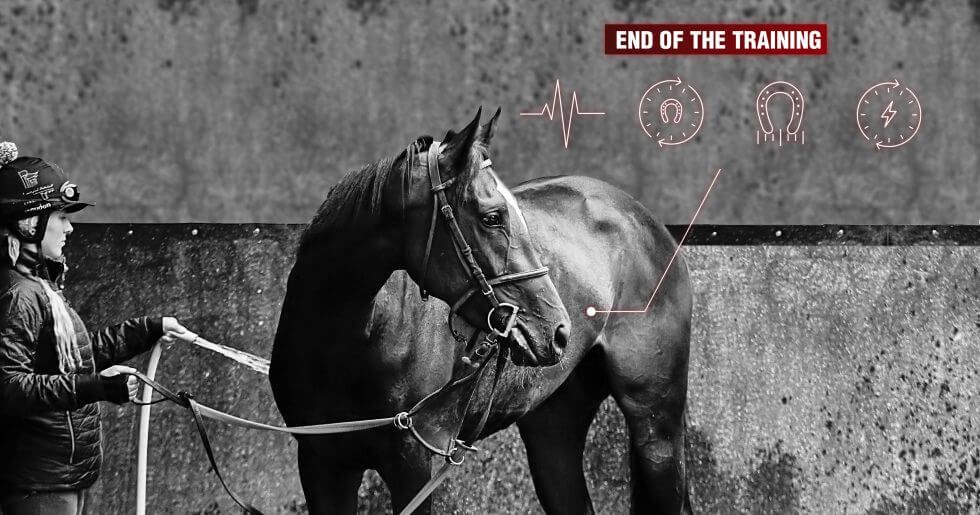Analysing the locomotion of your horses allows you to detect injuries or warning signs of pathologies. If a discomfort is present in a limb, the horse will adapt his way of moving in order to relieve his pain.
How does the data collected by EQUIMETRE enable locomotor pain to be detected? What situations require vigilance on the part of trainers?
Detecting injuries and emerging lameness in racehorses with locomotion analysis
Successfully identifying pain before it turns into an injury is one of EQUIMETRE’s main objectives. Monitoring the values of symmetry, regularity, stride frequency and stride length allows for longitudinal monitoring and completes the heart rate analysis.
How are locomotor parameters affected by pain? How do regularity and symmetry data change?
A horse in pain modifies his gait and locomotion in order to relieve his injured limb. The objective is to limit the efforts supported by this limb, in terms of duration and weight supported. In order to reduce the support time, the limb is put down for only a short moment before being supported. A suffering horse compensates with the other side by shifting his weight. It is therefore no longer symmetric at all.
Monitoring symmetry to prevent lameness
An increase in stride frequency can be synonymous with pain. Indeed, a large stride requires power from the painful limb so stride length will shorten and stride frequency will rise in order to maintain the speed asked by the rider. On top of that, symmetry and regularity deteriorate. In trotting, the deterioration of symmetry is particularly noticeable. The diagonal of the injured limb has a very short exposure time in comparison to that of the uninjured limb. The two diagonals no longer perform the same work. As for the regularity, it brings less indications. Monitoring the symmetry value of a young horse makes it possible to know his reference value and to be able to monitor the beginning of discomfort in a horse.
Increase in stride frequency: an interesting lameness warning sign
Any anomaly in stride frequency or stride length must be investigated. An injured horse reduces its stride length in order to reduce the force exerted on its supports. In order to accelerate, he therefore prefers to increase his pace by trying to limit his stride length as much as possible (Barrey, Auvinet and Couroucé, 1995). If, at a given speed, the stride frequency is much higher than usual, this may be a sign of an underlying problem that should be investigated if the situation does not improve.
Preventing locomotion risks through balanced training
Some specific exercises present a risk for some locomotor profiles. Knowing these situations and which horses are more likely to be affected allows for better risk control. At gallop, how can the rope be a risk depending on the lateralization of the horses? Why natural high stride lengths put horses more at risk?
Rope VS preferred foot
We saw that each horse had a privileged galloping foot. The foreleg associated with this side is therefore more trained than the other as the horse gallops more often on it. This forefoot is less fragile because it is more muscular (Rooney, 1983). However, the galloping foreleg is subject to much more stress and this is particularly true in the turns (Cogger et al., 2006). As soon as the horse changes feet to be on the side where he is least comfortable, his risk of injury is increasing. Running a right-handed horse on a left-hand rope track also presents more danger than if the horse had been left-handed. During the left turn, the left foreleg will be under greater stress than the right foreleg. However, the left foreleg is also more fragile than the right and injury could occur.
Natural large stride lengths require strong muscles
A great stride length, while beneficial in the race, must be handled with care. As the limbs land further from the body and faster, the forces applied to them are also greater. As the forces on the limbs are greater, there is a greater risk of injury. It is therefore advisable to wait until young horses or horses returning to training have had time to build up their muscles properly before asking them to go too fast.
The choice of the rope is essential to get the best results but also to preserve the horses. Asking for maximum speeds from young horses or horses lacking strength can be dangerous especially if they have a large stride length which is one of the main risk factors identified.
Keywords: lameness in racehorses, locomotion analysis, stride data, racehorse well-being, health management

